
Currents – Aquatic Conveyor Belts
The sea is a powerful force. It’s a huge energy storage and dispersal mechanism that absorbs forces like the Earth’s rotation, the Moon’s orbit and the wind and then releases them in various ways. Sometimes it dumps a huge amount of energy in one go (like a tsunami) but most of the time the power of the sea can be observed in the continuous movement of the currents and tides. These two forces are interrelated because a current can be formed from a tidal flow.
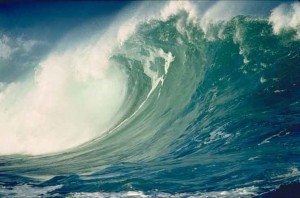
The Ocean Is A Biiiiiig Engine, And When It’s Really Roaring, It’s An Awesome Force!
Some currents are very mild and can be negotiated with ease. Other currents can make swimming against them very difficult because they flow too fast (or for too long). Once a current goes beyond around five knots it becomes too hard for us to swim against. In this instance you have a few choices; you can either swim for shore at a perpendicular angle to the current, which means an end to the dive. It is also possible to take advantage of the differences in speed of currents at different depths; a current is usually slower at the bottom because the ground creates resistance to the flow, so what some divers do if they end up caught in a current is they head down to the bottom and pull themselves along the sand or rocks because it is easier than swimming. The final option is the most fun though, if you suspect that the current is going to be much too strong to fight then you can simply request that the boat or car picks you up after you’ve finished drifting, this is called a “drift dive” (gosh those divers are a creative bunch!).
Drifting – The Benefits
Diving, for most of us, is a recreational pursuit. Most folks don’t dive because they have to, it’s usually because they enjoy some aspect of the hobby. The only reason someone would choose to modify their dive then, would be to make it more fun or easier. The drift dive is the epitome of fun and easy, though it favours ideal conditions and plenty of planning (more on that later).
Lazy Diving
Divers come in all shapes and sizes, they also come in all ages, fitness and abilities. Some divers relish going hard at it in a current for a sense of challenge and achievement. Others (myself included) are not insane, and enjoy easy dives where you are still capable of walking after getting out of the water. Drift diving is the absolute grand master of lazy diving because apart from the odd trajectory modifying kick or two, there is little to no swimming involved at all. This means that once a diver has jumped off the boat he is chauffeured from entry to exit at the sea’s own pace (and mercy). Many divers love the fact that they simply have to breathe to control their buoyancy, and kick to turn around or get closer to a buddy, and that is all there is to it. A great dive to do if your last dive was like being trapped on a treadmill!
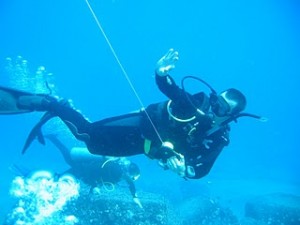
“OK”…Of Course It Is! You’re Drifting In An Underwater River, How Cool Is That?!
Air Conservation
An added upside to doing very little is that you tend to breathe much less. This won’t make much difference to those people that appear to breathe half from the sea and half from their bottle (you know who you are…fish-people-mutants! Your secret mermaid fellowship will be uncovered soon!), but for the normal mammals among us it can add a considerable amount of time to your dive. This becomes especially useful when your drift dive is also a deep dive because on a deep dive most divers struggle to make their air last as long as they’d like.
Reach Inaccessible Sites
Most large currents are prevailing currents, which means that they flow in one direction with very little deviation. They are constant streams of water, like underwater rivers. These never ending flows make it almost impossible to dive certain sites using conventional methods because they are simply much too strong to be swam against. The only option a diver has if he wishes to see the site is to allow the current to carry him along it. In some places (with overhead environments) this can require serious training, in other instances it will be like floating down a river.
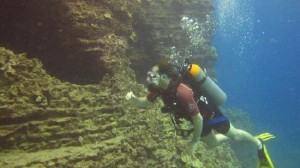
Wall Sites Often Have Serious Currents, Making Them Off-Limits To Conventional Divers…Good Thing I’m Not Conventional!
See Large Area
In some sites you have masses of flora and fauna densely packed and easy to spot. I’ve been on some sites where I’ve barely had enough time to clear my mask after laughing at an octopus, before I see a turtle. In other sites I’ve went an hour without seeing anything out of the ordinary. It is on sites like these that a drift dive can make a huge difference because you are able to cover large spaces in short periods of time, and you are able to stay longer because you don’t get as tired and your air supply lasts longer. This means you will have a higher chance of seeing those widely dispersed animals that require patience to find.
Fun
This is the real reason that I would organise a drift dive, because frankly it is an awesome experience to be free-falling sideways with almost no effort required to keep it going. The sensation of being carried along is at once exciting and, at the same time, very freeing. There is little you can do to change your course, so you must simply relax and enjoy it!
Equipment Considerations
Like any subsection of diving, drifting has it’s own gear requirements to assist in making it fun, easy and safe. Some of the gear you will use and carry anyway, other items are a little more specialised.
- A Boat Or Shore Crew – There is no doubt that drift diving is great fun, however, what isn’t fun is drifting three miles from your entry point off the shore, and then realising once you exit the water that your car is three miles away…nobody wants to be dripping wet, in a wet suit, carrying heavy gear for three miles. The answer to this problem is to have a boat follow your progress on the surface, alternatively you can have a shore team follow your progress (assuming they can drive along the shoreline).
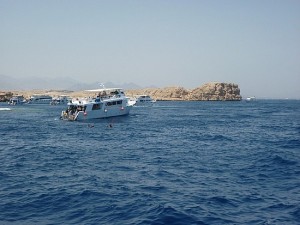
- Any Boat Will Suffice For Drift Diving, Just As Long As It’s Captained By An Experienced Boatman.
- Float or Buoy – The idea of simply moving your exit point to wherever you surface is very desirable (not to mention convenient!), however it is almost impossible for a boat to track you underwater using your bubble trail if the surface is choppy or the dive is at night (and even harder for the shore team). The way most divers overcome this is by using a surface float which marks the diver’s position and allows the surface team to follow the divers and meet them when they surface. The float must be very buoyant, highly visible, have lights on it for night dives and may be required to have a flag on it. These floats should be specially designed dive floats, don’t improvise one out of a few juice bottles taped together, this float must be able to remain floating even when a strong current pulls down on it.
- Line – It is obvious that the float will not remain above the diver without some sort of tether, but it is not advisable that you improvise this either. A strong one centimetre nylon line on a free-moving reel is the best choice. It should be at least double your planned depth to allow sufficient slack for if the float moves ahead of you (surface currents are usually faster than deep ones). You may also attach a grapple to the end of the line to allow you to anchor the float when you choose to stop. This doesn’t mean that you can ram a hook into a finger coral, it means you can use it to grip to a rock, or anchor into the sand.
- Signal Devices – Not all dives go exactly to plan and sometimes a diver will loose his float or the boat might loose track of a diver. In this case it is important for the diver to have an audible and visual means of attracting the boats attention. Usually a whistle is carried, but an air horn attached to the low pressure inflator hose works well too. For visual signals a torch is the obvious choice at night, and a large SMB works well for day dives.
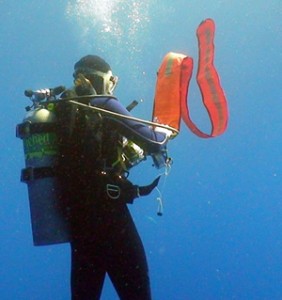
- During The Day You Are Much More Likely To Be Seen If You Use A SMB To Signal The Boat.
- Knife or Pointer – Here comes reason two-hundred and fifty-three for carrying a knife with you at all times: during a drift you may spot something that you wish to inspect further, but the nature of a drift dive is that you can’t (always) swim against it – so you may need to anchor yourself to something. The best bet is to use a (strong) knife or metal pointer stick and stab it into the sand. Obviously if you are on a reef then this might prove tricky, but it is always better to touch sand than coral. A knife can also help free a line-handler who’s been tangled up in the float-line.
Risks
With great fun comes mild risk…
- DCS – Currents are strange phenomena that, although they may appear constant can change slightly with tides or different temperatures of water combining (as may happen after a heavy rainfall, or when you pass a river mouth when in the sea). This change might affect the direction of the current but it is more likely to affect the vertical properties of the water stream. What could happen if you’re drifting along the shore is you hit a freshwater pocket (from the river) which will suddenly make you negatively buoyant, in this case it would be easy for a diver to be unaware of the situation or simply be overweighted for fresh water and they might descend too fast or too deep. Another risk is that the current drags you down too far which, if it happens at the end of a dive, might push you into decompression diving which could be an issue when drifting in a fast current and low on air. Currents can also surface you too quickly, which is another DCS risk. Pay extra attention to your buoyancy when drift diving because things change fast when you travel quickly.
- Getting Lost – It’s not a hidden secret that you may get lost when drift diving. It’s more of a problem than conventional diving because the search is heavily hampered by the current. It means that if one diver gets lost then all the divers in the group must surface because drift divers stay as a group – this is their first priority, otherwise the boat is unable to keep track of who is where in the drift. It is also possible for the boat to loose the whole group, in this instance the important thing is to fully brief all the divers on the emergency procedures and ensure that everyone has their own signalling devices. Extra spotters on the boat or shore are an advantage too.
- Collisions – To fly a plane takes great skill and training, this is because they are moving fast in three dimensions which takes practice. When you are drifting you will also be in a three-dimensional space, and you will be moving (relatively) fast. There are also many more obstacles under the sea than in the air (last time I checked) which means you must be super-observant when cruising the currents. You should have your eyes open for not just coral and rocks, but for creatures, such as jellies, stonefish or a spooked triggerfish.

- Drift Diving Is The Closest You’ll Ever Get To Flying Without Wings…Just Don’t Crash!
- Exhaustion – Despite me promoting drift diving as a lazy way to see the underwater world, it can sometimes require great amounts of effort from the diver. This is especially the case when you are required to swim on the same spot in order to see something or let the group catch up. Sometimes there are no viable things to anchor onto so you just have to swim against the current which can be a nightmare. Beware of exhausting yourself, especially if you go deep.
Special Techniques
Stern Line
When divers are leaving or embarking the boat there is always the risk that they simply keep on drifting at a rate faster than the boat. To prevent this issue most boats will trail a stern line which is just a buoy on the end of a long rope. This gives the divers a much better chance of “catching” the boat as they come alongside it. It also allows the group of divers to collect before or after a dive while waiting for the stragglers to jump in or climb onto the boat. These lines are notorious for tangling up divers though, so be careful when clinging onto one.
Buoyant or Negative Entries
There are two ways to descend onto a drift site, the first is to gather all the divers on the surface and ensure full positive buoyancy. This method is good for ensuring there are no problems before descending but it can be a problem if the dive site is small as you may drift past it on the surface before you have descended. The other option is to have the whole group jump into the water with their bcd empty so they hit the water negatively buoyant. This ensures the group gets down to the site rapidly, but it means the divers must find the float line as they descend to ensure everyone ends up in the same spot. Negative entries are only for experienced divers because novice divers often have ear troubles and other concerns, an experienced diver will sink like a stone and get going.
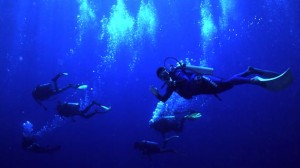
When Making A Negative Descent, It Is Important To Ensure All The Divers Stay Well Within Visual Range Of The Line-Holder.
Final Thoughts
I really hope this article has inspired some of you to go research drift diving further because it’s one of the most fun and rewarding types of dive on offer. Please don’t use this article as a handbook, it is only intended to highlight a few of the opportunities and risks involved with this crazy sub-sport. If you want to drift dive then make sure your first attempt is with a fully qualified dive outfit who have procedures in place to ensure it goes smoothly.
Are you an avid drifter? Is it a sport you’d like to try? Have you got any interesting or sobering stories from drift diving? We’d love to hear your thoughts, please use the comment section below.
Happy (drifting) Bubbles!